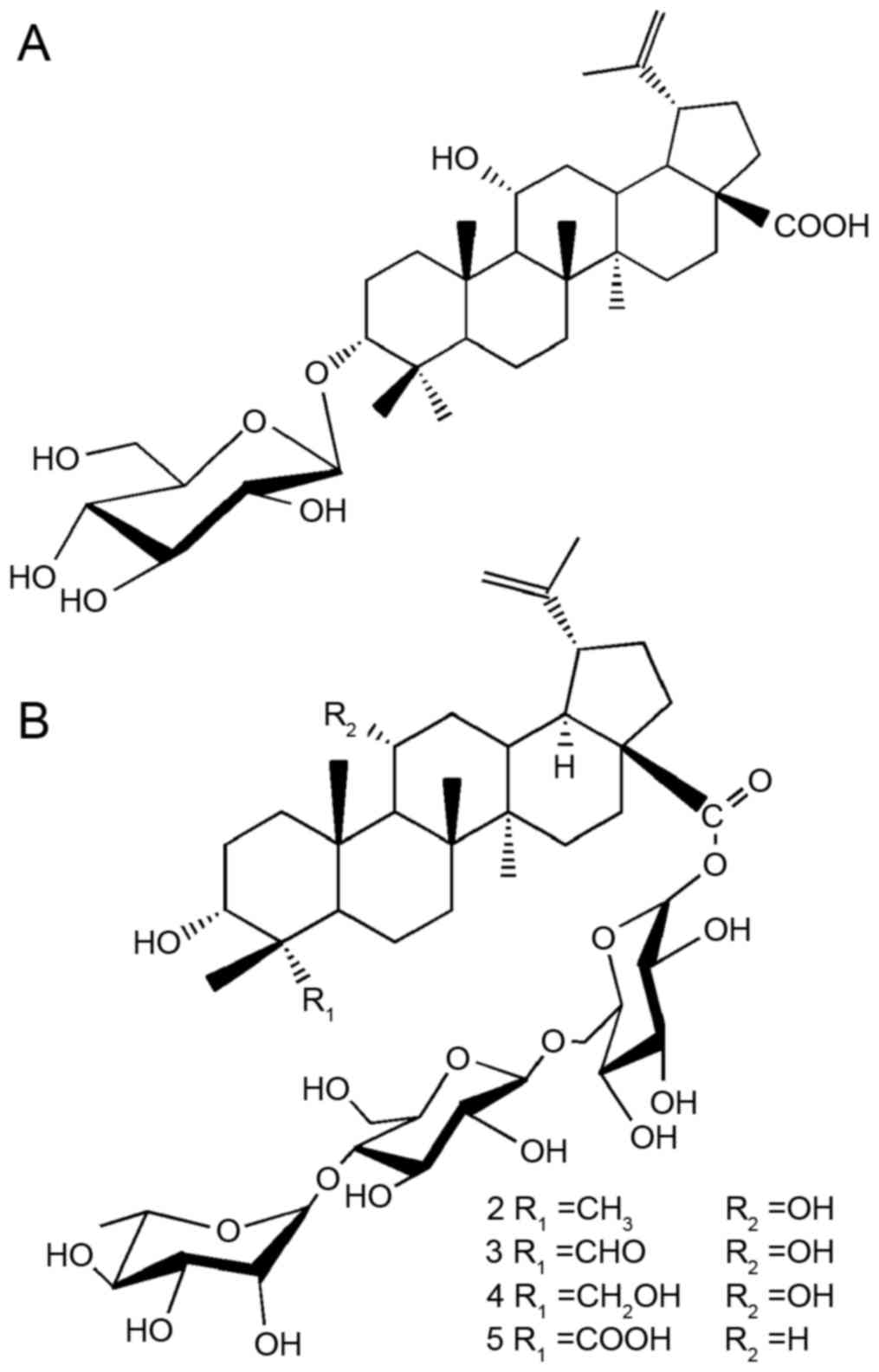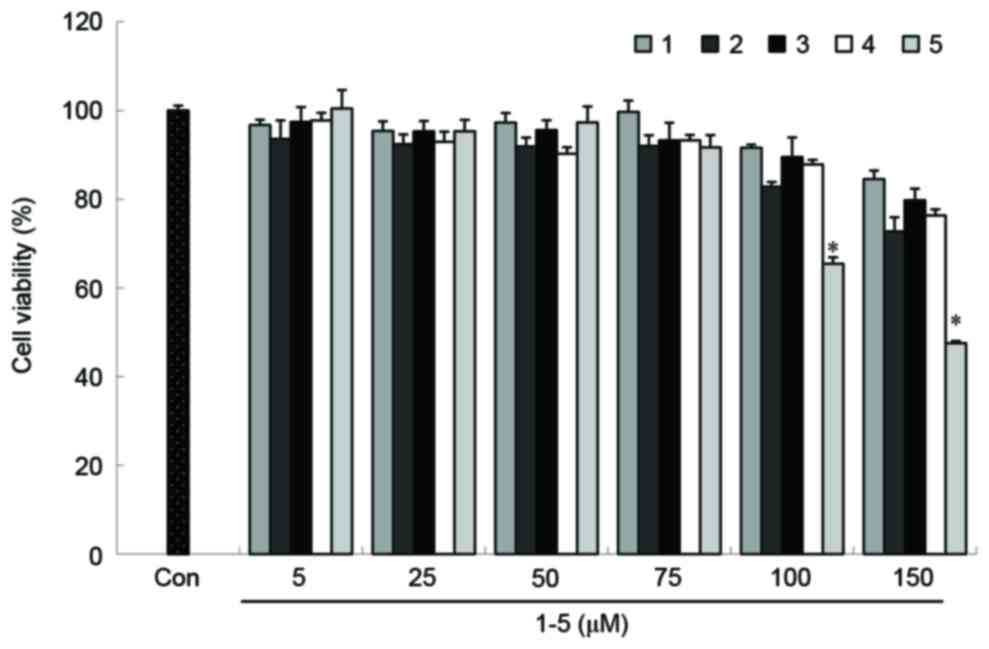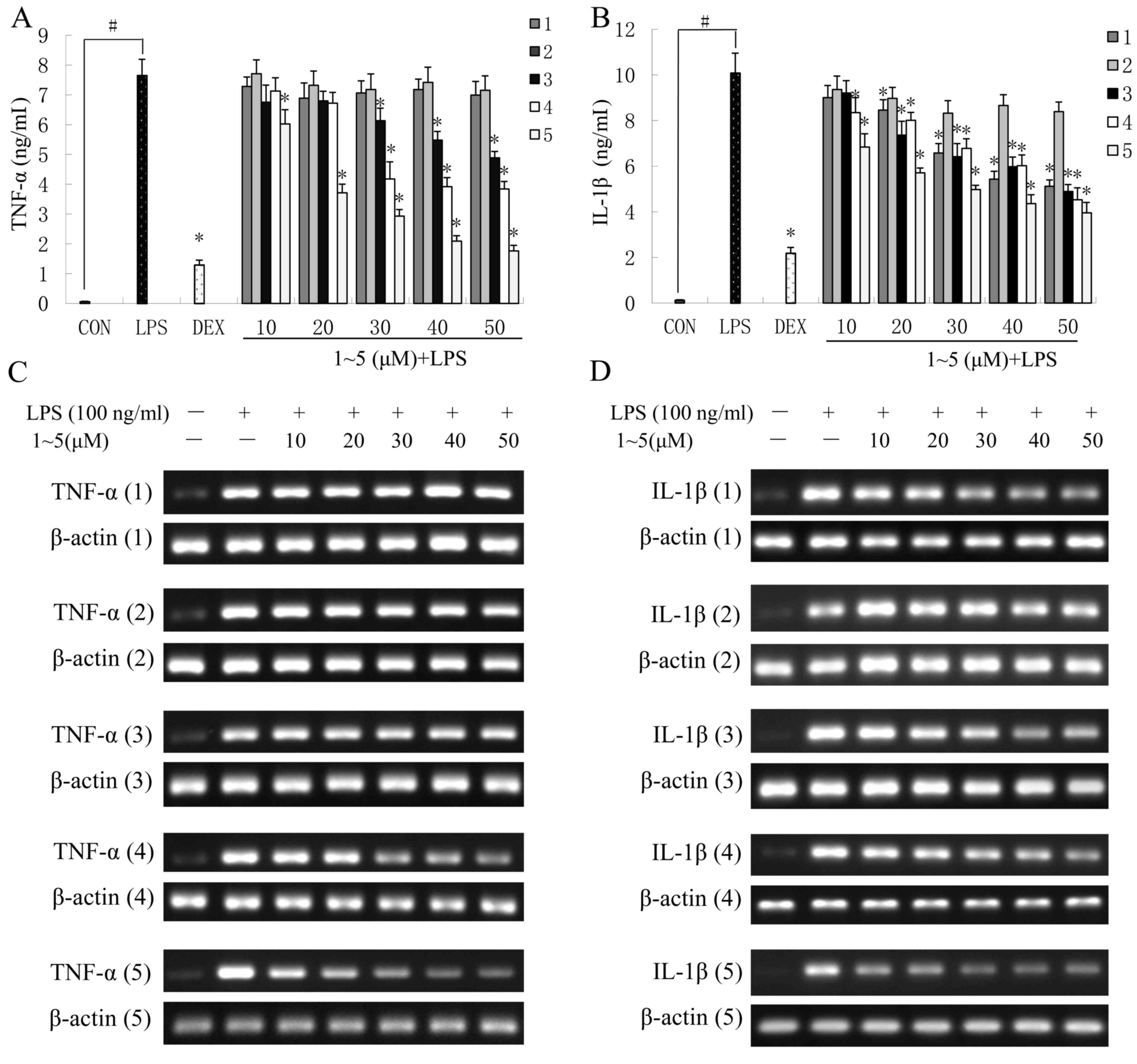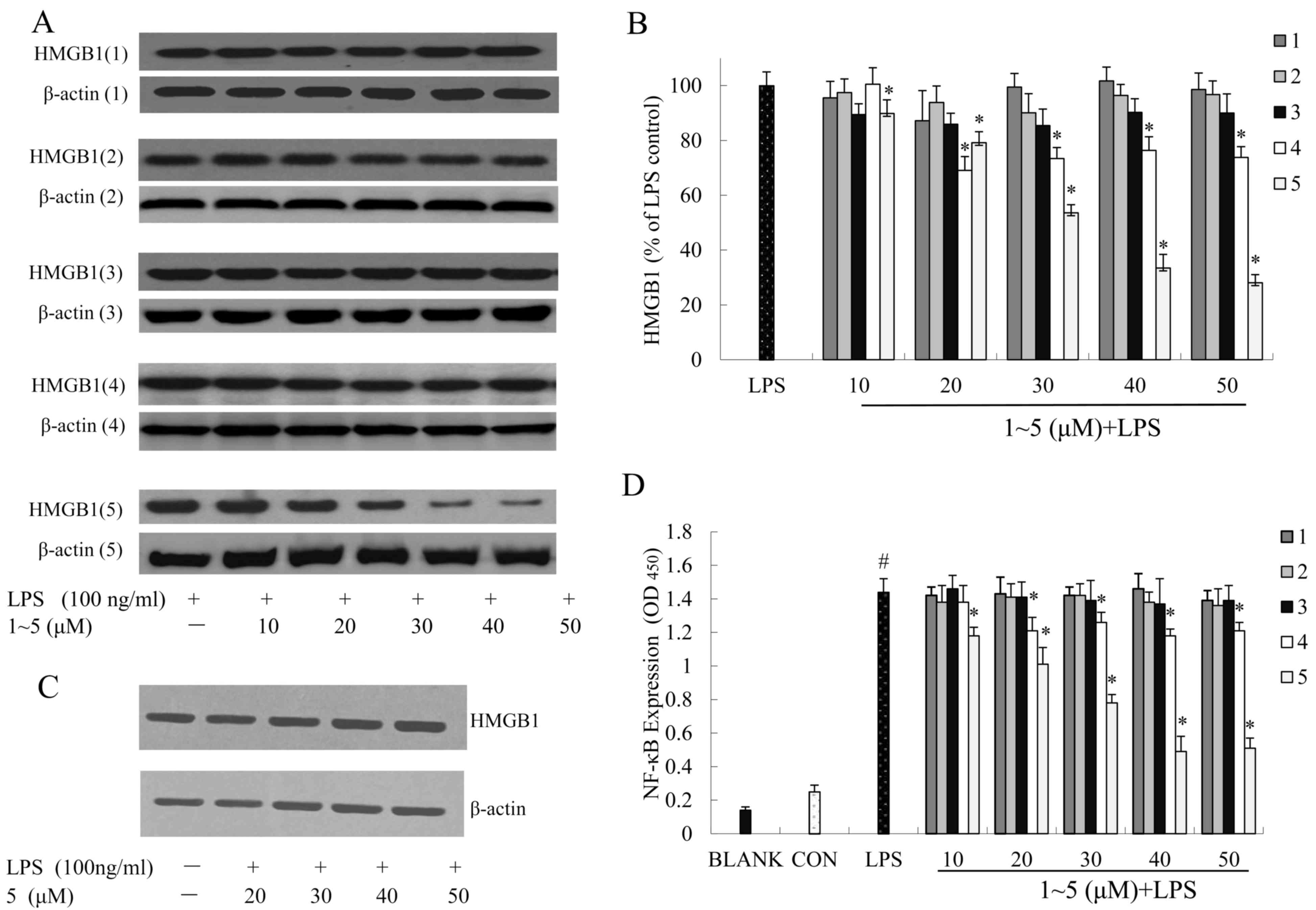|
1
|
Morson BC: Pathology of inflammatory
disease. Proc R Soc Med. (63 Suppl): pp. S631970;
|
|
2
|
Gholijani N, Gharagozloo M, Farjadian S
and Amirghofran Z: Modulatory effects of thymol and carvacrol on
inflammatory transcription factors in lipopolysaccharide-treated
macrophages. J Immunotoxicol. 13:157–164. 2016. View Article : Google Scholar : PubMed/NCBI
|
|
3
|
Akira S, Hirano T, Taga T and Kishimoto T:
Biology of multifunctional cytokines: IL 6 and related molecules
(IL 1 and TNF). FASEB J. 4:2860–2867. 1990.PubMed/NCBI
|
|
4
|
Beutler B and Cerami A: Cachectin and
tumour necrosis factor as two sides of the same biological coin.
Nature. 320:584–588. 1986. View
Article : Google Scholar : PubMed/NCBI
|
|
5
|
Wang H, Bloom O, Zhang M, Vishnubhakat JM,
Ombrellino M, Che J, Frazier A, Yang H, Ivanova S, Borovikova L, et
al: HMG-1 as a late mediator of endotoxin lethality in mice.
Science. 285:248–251. 1999. View Article : Google Scholar : PubMed/NCBI
|
|
6
|
Bustin M: Regulation of DNA-dependent
activities by the functional motifs of the high-mobility-group
chromosomal proteins. Mol Cell Biol. 19:5237–5246. 1999. View Article : Google Scholar : PubMed/NCBI
|
|
7
|
Abraham E, Arcaroli J, Carmody A, Wang H
and Tracey KJ: HMG-1 as a mediator of acute lung inflammation. J
Immunol. 165:2950–2954. 2000. View Article : Google Scholar : PubMed/NCBI
|
|
8
|
Scaffidi P, Misteli T and Bianchi ME:
Release of chromatin protein HMGB1 by necrotic cells triggers
inflammation. Nature. 418:191–195. 2002. View Article : Google Scholar : PubMed/NCBI
|
|
9
|
Lotze MT and Tracey KJ: High-mobility
group box 1 protein (HMGB1): Nuclear weapon in the immune arsenal.
Nat Rev Immunol. 5:331–342. 2005. View
Article : Google Scholar : PubMed/NCBI
|
|
10
|
Andersson U and Tracey KJ: HMGB1 is a
therapeutic target for sterile inflammation and infection. Annu Rev
Immunol. 29:139–162. 2011. View Article : Google Scholar : PubMed/NCBI
|
|
11
|
Harris HE and Raucci A: Alarmin (g) news
about danger: Workshop on innate danger signals and HMGB1. EMBO
Rep. 7:774–778. 2006.PubMed/NCBI
|
|
12
|
Bianchi ME: DAMPs, PAMPs and alarmins: All
we need to know about danger. J Leukoc Biol. 81:1–5. 2007.
View Article : Google Scholar : PubMed/NCBI
|
|
13
|
Andersson U, Wang H, Palmblad K, Aveberger
AC, Bloom O, Erlandsson-Harris H, Janson A, Kokkola R, Zhang M,
Yang H and Tracey KJ: High mobility group 1 protein (HMG-1)
stimulates proinflammatory cytokine synthesis in human monocytes. J
Exp Med. 192:565–570. 2000. View Article : Google Scholar : PubMed/NCBI
|
|
14
|
Sha Y, Zmijewski J, Xu Z and Abraham E:
HMGB1 develops enhanced proinflammatory activity by binding to
cytokines. J Immunol. 180:2531–2537. 2008. View Article : Google Scholar : PubMed/NCBI
|
|
15
|
Li X, Wang LK, Wang LW, Han XQ, Yang F and
Gong ZJ: Cisplatin protects against acute liver failure by
inhibiting nuclear HMGB1 release. Int J Mol Sci. 14:11224–11237.
2013. View Article : Google Scholar : PubMed/NCBI
|
|
16
|
Chang Y, Huang X, Liu Z, Han G, Huang L,
Xiong YC and Wang Z: Dexmedetomidine inhibits the secretion of high
mobility group box 1 from lipopolysaccharide-activated macrophages
in vitro. J Surg Res. 181:308–314. 2013. View Article : Google Scholar : PubMed/NCBI
|
|
17
|
Shan BE, Yoshita Y, Sugiur T and Yamashita
U: Suppressive effect of Chinese medicinal herb, Acanthopanax
gracilistylus, extract on human lymphocytes in vitro. Clin Exp
Immunol. 118:41–48. 1999. View Article : Google Scholar : PubMed/NCBI
|
|
18
|
China Pharmacopoeia Commission:
Pharmacopoeia of People's Republic of China. 1. Chinese Medical
Science and Technology Press; Beijing: pp. 612010
|
|
19
|
Cai XF, Lee IS, Shen G, Dat NT, Lee JJ and
Kim YH: Triterpenoids from Acanthopanax koreanum root and their
inhibitory activities on NFAT transcription. Arch Pharm Res.
27:825–828. 2004. View Article : Google Scholar : PubMed/NCBI
|
|
20
|
Park SH, Nhiem NX, Kiem PV, Choi EM, Kim
JA and Kim YH: A new norlupane triterpene from the leaves of
Acanthopanax koreanum increases the differentiation of osteoblastic
MC3T3-e1 cells. Arch Pharm Res. 33:75–80. 2010. View Article : Google Scholar : PubMed/NCBI
|
|
21
|
Wu YL, Jiang YZ, Jin XJ, Lian LH, Piao JY,
Wan Y, Jin HR, Lee J Joon and Nan JX: Acanthoic acid, a diterpene
in Acanthopanax koreanum, protects acetaminophen-induced hepatic
toxicity in mice. Phytomedicine. 17:475–479. 2010. View Article : Google Scholar : PubMed/NCBI
|
|
22
|
Nhiem NX, Kiem PV, Minh CV, Tai BH, Tung
NH, Ha do T, Soung KS, Kim JH, Ahn JY, Lee YM and Kim YH:
Structure-activity relationship of lupane-triterpene glycosides
from Acanthopanax koreanum on spleen lymphocyte IL-2 and IFN-gamma.
Bioorg Med Chem Lett. 20:4927–4931. 2010. View Article : Google Scholar : PubMed/NCBI
|
|
23
|
Huang WC, Li Z, Li XJ, Gong LM, Liu XQ,
Kwon OK, Ye HX and Lee HK: Chemical composition, anti-inflammatory
activity and cytotoxic activity of the liposoluble constituents
from different parts of Acanthopanax evodiaefolius by the Herbal
Blitzkrieg Extractor. Environ Toxicol Pharmacol. 38:406–411. 2014.
View Article : Google Scholar : PubMed/NCBI
|
|
24
|
Yook CS, Liu XQ, Chang SY, Park SY and
Nohara T: Lupane triterpene glycosides from the leaves of
Acanthopanax gracilistylus. Chem Pharm Bull (Tokyo). 50:1383–1385.
2002. View Article : Google Scholar : PubMed/NCBI
|
|
25
|
Liu XQ, Yook CS and Chang SY: Chemical
constituents of Acanthopanax gracilistylus. Chin Tradit Herb Drugs.
35:250–252. 2004.(In Chinese).
|
|
26
|
Liu XQ, Chang SY, Park SY, Nohara T and
Yook CS: A new lupane triterpene glycosides from the leaves of
Acanthopanax gracilistylus. Arch Pharm Res. 25:831–836. 2002.
View Article : Google Scholar : PubMed/NCBI
|
|
27
|
Zou QP, Liu XQ, Lee HK and Oh OJ: Lupane-
triterpenoids from the methanol extracts of leaves of Acanthopanax
gracilistylus W.W. Smith. J Lanzhou Univ (Natural Sciences).
47:120–126. 2011.
|
|
28
|
Ulloa L and Messmer D: High-mobility group
box 1 (HMGB1) protein: Friend and foe. Cytokine Growth Factor Rev.
17:189–201. 2006. View Article : Google Scholar : PubMed/NCBI
|
|
29
|
Otterlei M, Ostgaard K, Skjåk-Braek G,
Smidsrød O, Soon-Shiong P and Espevik T: Induction of cytokine
production from human monocytes stimulated with alginate. J
Immunother (1991). 10:286–291. 1991. View Article : Google Scholar : PubMed/NCBI
|
|
30
|
Fiedler VB, Loof I, Sander E, Voehringer
V, Galanos C and Fournel MA: Monoclonal antibody to tumor necrosis
factore alpha prevents lethal endotoxin sepsis in adult rhesus
monkeys. J Lab Clin Med. 120:574–588. 1992.PubMed/NCBI
|
|
31
|
Van der Poll T, Levi M, Hack CE, ten Cate
H, van Deventer SJ, Eerenberg AJ, de Groot ER, Jansen J, Gallati H,
Büller HR, et al: Elimination of interleukin 6 attenuates
coagulation activation in experimental endotoxemia in chimpanzees.
J Exp Med. 179:1253–1259. 1994. View Article : Google Scholar : PubMed/NCBI
|
|
32
|
Van der Poll T, Levi M, van Deventer SJ,
ten Cate H, Haagmans BL, Biemond BJ, Büller HR, Hack CE and ten
Cate JW: Differential effects of anti-tumor necrosis factor
monoclonal antibodies on systemic inflammatory responses in
experimental endotoxemia in chimpanzees. Blood. 83:446–451.
1994.PubMed/NCBI
|
|
33
|
Fisher CJ Jr, Dhainaut JF, Opal SM,
Pribble JP, Balk RA, Slotman GJ, Iberti TJ, Rackow EC, Shapiro MJ,
Greenman RL, et al: Recombinant human interleukin 1 receptor
antagonist in the treatment of patients with sepsis syndrome:
Results from a randomized, double-blind, placebo-controlled trial.
Phase III rhIL-1ra Sepsis Syndrome Study Group. JAMA.
271:1836–1843. 1994. View Article : Google Scholar : PubMed/NCBI
|
|
34
|
Abraham E, Anzueto A, Gutierrez G, Tessler
S, San Pedro G, Wunderink R, Dal Nogare A, Nasraway S, Berman S,
Cooney R, et al: Double-blind randomised controlled trial of
monoclonal antibody to human tumour necrosis factor in treatment of
septic shock. NORASEPT II Study Group. Lancet. 351:929–933. 1998.
View Article : Google Scholar : PubMed/NCBI
|
|
35
|
Gao H, Wu L, Kuroyanagi M, Harada K,
Kawahara N, Nakane T, Umehara K, Hirasawa A and Nakamura Y:
Antitumor-promoting constituents from Chaenomeles sinensis KOEHNE
and their activities in JB6 mouse epidermal cells. Chem Pharm Bull
(Tokyo). 51:1318–1321. 2003. View Article : Google Scholar : PubMed/NCBI
|
|
36
|
Fogo AS, Antonioli E, Calixto JB and
Campos AH: Tormentic acid reduces vascular smooth muscle cell
proliferation and survival. Eur J Pharmacol. 615:50–54. 2009.
View Article : Google Scholar : PubMed/NCBI
|













